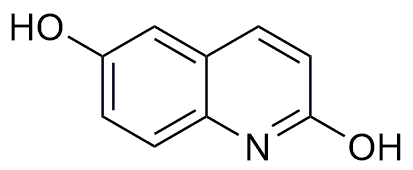2,6-Dihydroxyquinoline is widely utilized in research focused on:
- Antimicrobial Agents: This compound shows potential as an antimicrobial agent, making it valuable in the development of new antibiotics to combat resistant bacterial strains.
- Fluorescent Probes: Its unique fluorescent properties allow it to be used in biological imaging, aiding researchers in tracking cellular processes in real-time.
- Metal Ion Detection: 2,6-Dihydroxyquinoline can selectively bind to certain metal ions, making it useful in environmental monitoring and analysis of heavy metals in water sources.
- Pharmaceutical Development: The compound serves as a building block in synthesizing various pharmaceuticals, particularly in the creation of drugs targeting neurological disorders.
- Organic Synthesis: It is employed in organic synthesis reactions, providing a versatile tool for chemists in creating complex molecules efficiently.
General Information
Properties
Safety and Regulations
Applications
2,6-Dihydroxyquinoline is widely utilized in research focused on:
- Antimicrobial Agents: This compound shows potential as an antimicrobial agent, making it valuable in the development of new antibiotics to combat resistant bacterial strains.
- Fluorescent Probes: Its unique fluorescent properties allow it to be used in biological imaging, aiding researchers in tracking cellular processes in real-time.
- Metal Ion Detection: 2,6-Dihydroxyquinoline can selectively bind to certain metal ions, making it useful in environmental monitoring and analysis of heavy metals in water sources.
- Pharmaceutical Development: The compound serves as a building block in synthesizing various pharmaceuticals, particularly in the creation of drugs targeting neurological disorders.
- Organic Synthesis: It is employed in organic synthesis reactions, providing a versatile tool for chemists in creating complex molecules efficiently.
Documents
Safety Data Sheets (SDS)
The SDS provides comprehensive safety information on handling, storage, and disposal of the product.
Product Specification (PS)
The PS provides a comprehensive breakdown of the product’s properties, including chemical composition, physical state, purity, and storage requirements. It also details acceptable quality ranges and the product's intended applications.
Certificates of Analysis (COA)
Search for Certificates of Analysis (COA) by entering the products Lot Number. Lot and Batch Numbers can be found on a product’s label following the words ‘Lot’ or ‘Batch’.
Numéro de catalogue
Numéro de lot/série
Certificates Of Origin (COO)
This COO confirms the country where the product was manufactured, and also details the materials and components used in it and whether it is derived from natural, synthetic, or other specific sources. This certificate may be required for customs, trade, and regulatory compliance.
Numéro de catalogue
Numéro de lot/série
Safety Data Sheets (SDS)
The SDS provides comprehensive safety information on handling, storage, and disposal of the product.
DownloadProduct Specification (PS)
The PS provides a comprehensive breakdown of the product’s properties, including chemical composition, physical state, purity, and storage requirements. It also details acceptable quality ranges and the product's intended applications.
DownloadCertificates of Analysis (COA)
Search for Certificates of Analysis (COA) by entering the products Lot Number. Lot and Batch Numbers can be found on a product’s label following the words ‘Lot’ or ‘Batch’.
Numéro de catalogue
Numéro de lot/série
Certificates Of Origin (COO)
This COO confirms the country where the product was manufactured, and also details the materials and components used in it and whether it is derived from natural, synthetic, or other specific sources. This certificate may be required for customs, trade, and regulatory compliance.

